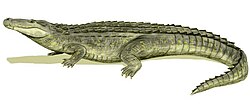References
- ↑ Lucas, S.G. (2001). "Paleogene". Chinese Fossil Vertebrates . New York: Columbia University Press. pp. 229. ISBN 9780231084833.
- ↑ Brochu, C. A. (2004). "A new Late Cretaceous gavialoid crocodylian from Eastern North America and the phylogenetic relationships of Thoracosaurs" (PDF). Journal of Vertebrate Paleontology. 24 (3): 610–633. doi:10.1671/0272-4634(2004)024[0610:anlcgc]2.0.co;2. S2CID 131176447.
Extinct crocodilians | |||||||||||||||||||||||||||||||||||||||||||
|---|---|---|---|---|---|---|---|---|---|---|---|---|---|---|---|---|---|---|---|---|---|---|---|---|---|---|---|---|---|---|---|---|---|---|---|---|---|---|---|---|---|---|---|
| |||||||||||||||||||||||||||||||||||||||||||
| |||||||||||||||||||||||||||||||||||||||||||
| |||||||||||||||||||||||||||||||||||||||||||
| |||||||||||||||||||||||||||||||||||||||||||
| |||||||||||||||||||||||||||||||||||||||||||
| Tienosuchus | |
|---|---|
| | This article about a prehistoric archosaur is a stub. You can help Wikipedia by expanding it. |


